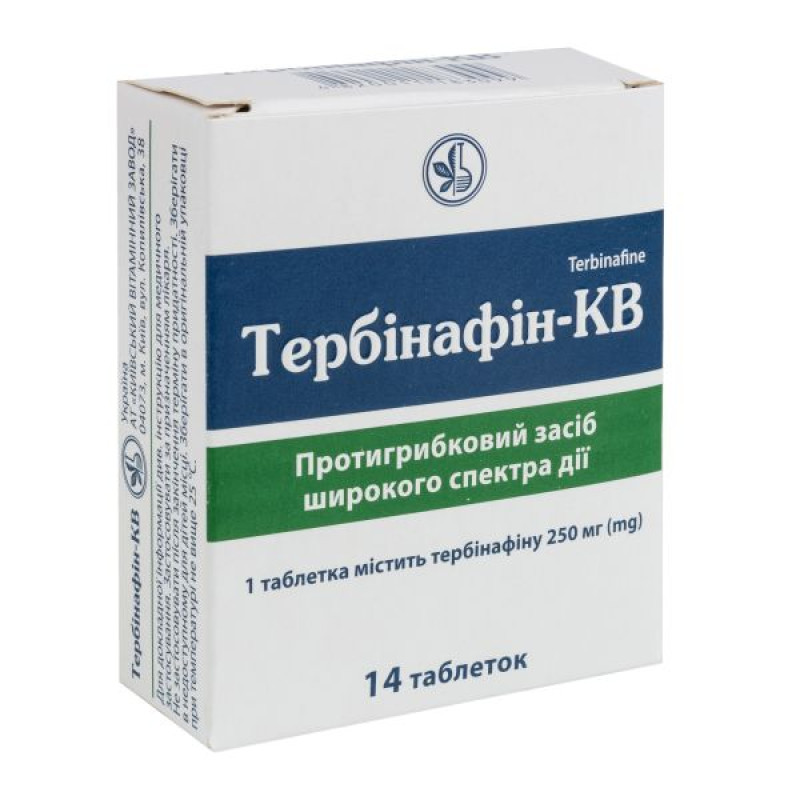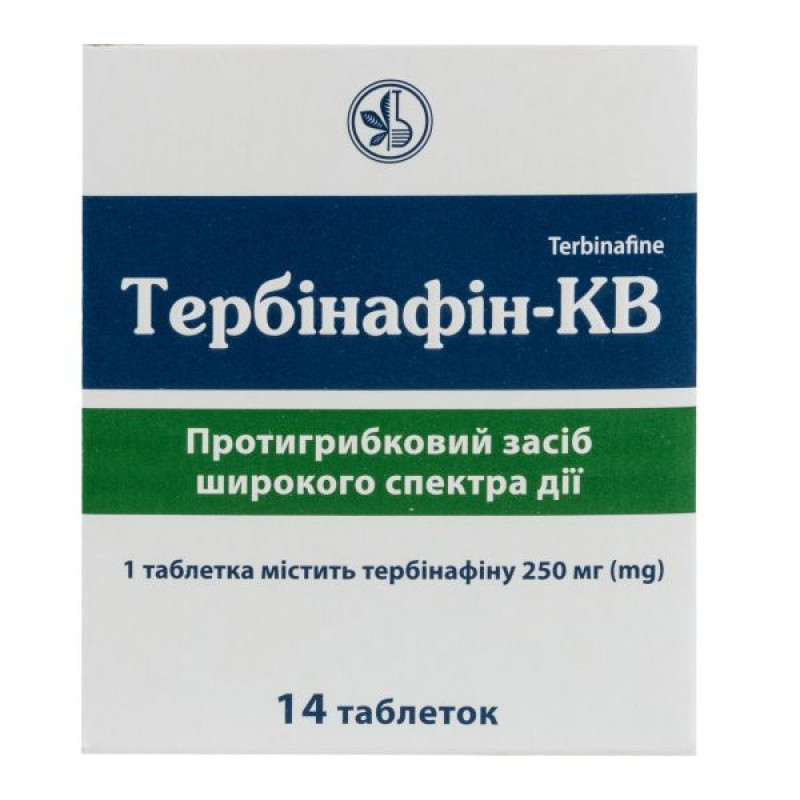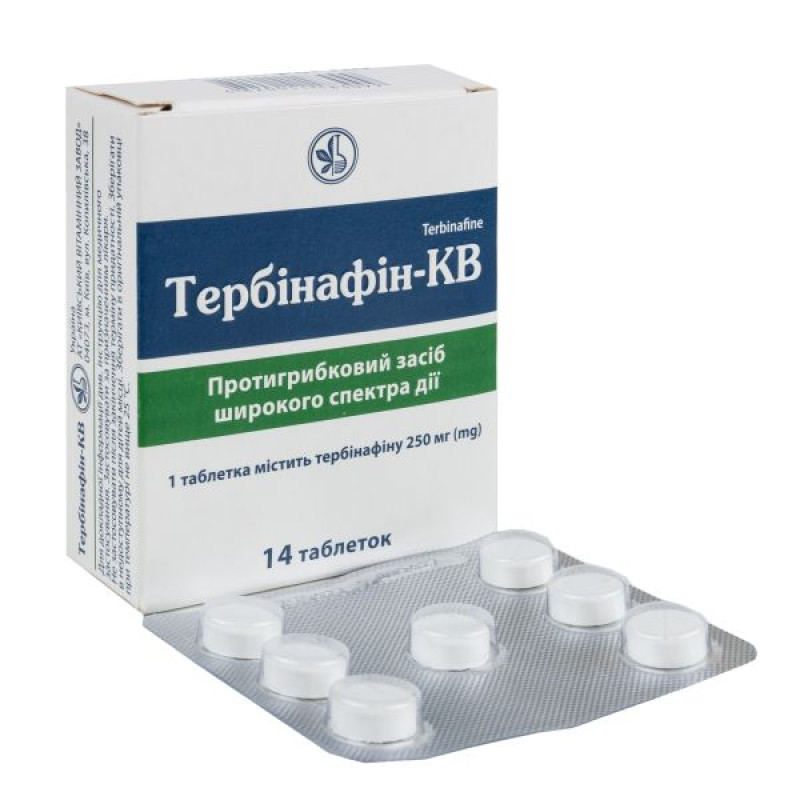Terbinafine-KV tablets 250 mg blister No. 14

Instructions for use Terbinafine-KV tablets 250 mg blister No. 14
Composition
active ingredient: terbinafine;
1 tablet contains terbinafine hydrochloride equivalent to terbinafine 250 mg;
Excipients: microcrystalline cellulose, corn starch, sodium starch glycolate (type A), colloidal anhydrous silica, magnesium stearate, hypromellose (hydroxypropylmethylcellulose).
Dosage form
Pills.
Main physicochemical properties: flat-cylindrical tablets with beveled edges and a score, white or almost white in color.
Pharmacotherapeutic group
Antifungal drugs for use in dermatology. Antifungal drugs for systemic use. Terbinafine. ATX code D01B A02.
Pharmacological properties
Pharmacodynamics
Terbinafine is an allylamine with a broad spectrum of antifungal activity against skin, hair and nail infections caused by dermatophytes such as Trichophyton (e.g. T. rubrum, T. mentagrophytes, T. verrucosum, T. tonsurans, T. violaceum), Microsporum (e.g. Microsporum canis), Epidermophyton floccosum and yeasts of the genus Candida (e.g. Candida albicans) and Pityrosporum. At low concentrations, terbinafine exhibits fungicidal activity against dermatophytes, molds and some dimorphic fungi. The activity against yeasts, depending on their species, can be fungicidal or fungistatic.
Terbinafine specifically promotes the early stage of sterol biosynthesis in the fungal cell. This leads to ergosterol deficiency and intracellular accumulation of squalene, which causes the death of the fungal cell. The action of terbinafine is carried out by inhibiting the enzyme squalene epoxidase in the fungal cell membrane. This enzyme does not belong to the cytochrome P450 system.
When applied internally, the drug accumulates in the skin in concentrations that provide a fungicidal effect.
Pharmacokinetics
After oral administration, terbinafine is well absorbed (> 70%); the absolute bioavailability of terbinafine, which is part of the drug Terbinafine-KV in tablets, as a result of presystemic metabolism is about 50%.
A single oral dose of 250 mg terbinafine produced mean peak plasma concentrations of 1.3 μg/ml 1.5 hours after dosing. At steady state, the maximum concentration of terbinafine was on average 25% higher and the plasma AUC increased 2.3-fold compared to a single dose. Based on the increase in plasma AUC, an effective half-life (30 hours) can be calculated.
Food intake has a moderate effect on the bioavailability of terbinafine (increase in AUC by less than 20%), but not enough to require dose adjustment.
Terbinafine is highly bound to plasma proteins. It diffuses rapidly through the dermis and concentrates in the lipophilic stratum corneum.
Terbinafine is also secreted into sebum and thus reaches high concentrations in hair follicles, hair and sebum-rich skin. Terbinafine has also been shown to be distributed into the nail plates during the first weeks after initiation of therapy.
Terbinafine is metabolized rapidly and extensively by at least seven CYP isoenzymes with significant contributions from CYP2C9, CYP1A2, CYP3A4, CYP2C8 and CYP2C19.
Terbinafine biotransformation produces metabolites that have no antifungal activity and are excreted mainly in the urine. The half-life of the drug is 17 hours. There is no evidence of accumulation of the drug in the body.
No changes in the pharmacokinetics of the drug are observed depending on the patient's age, but the rate of drug elimination from the body may be reduced in patients with impaired renal or hepatic function, leading to increased levels of terbinafine in the blood.
The bioavailability of the drug Terbinafine-KV is independent of food intake.
Single-dose pharmacokinetic studies in patients with renal impairment (creatinine clearance < 50 ml/min) or pre-existing liver disease have shown that the clearance of Terbinafine-KV may be reduced by approximately 50%.
Indication
Fungal infections of the skin and nails caused by Trichophyton (e.g. T. rubrum, T. mentagrophytes, T. verrucosum, T. violaceum), Microsporum canis and Epidermophyton floccosum. Ringworm (tinea smooth muscle, tinea versicolor and tinea pedis) when the location, severity or extent of the infection makes oral therapy appropriate. Onychomycosis.
Contraindication
Hypersensitivity to terbinafine or to any of the excipients of the drug.
Interaction with other medicinal products and other types of interactions
Effects of other drugs on terbinafine
The plasma clearance of terbinafine may be increased by drugs that induce metabolism and may be decreased by drugs that inhibit cytochrome P450. If concomitant treatment with such drugs is necessary, the dosage of Terbinafine-KV should be adjusted accordingly.
Drugs that may increase the exposure or plasma concentrations of terbinafine
Fluconazole increased the Cmax and AUC of terbinafine by 52% and 69%, respectively, due to inhibition of CYP2C9 and CYP3A4 enzymes. The same increase may be observed when terbinafine is co-administered with drugs that inhibit CYP2C9 and CYP3A4, such as ketoconazole and amiodarone.
Drugs that may reduce the effects or plasma concentrations of terbinafine
Rifampicin increased the clearance of terbinafine by 100%.
Effects of terbinafine on other drugs
Terbinafine is known to have a minor potential to inhibit or increase the clearance of drugs metabolized by the cytochrome P450 system (e.g. terfenadine, triazolam, tolbutamine or oral contraceptives), with the exception of those drugs metabolized by CYP2D6.
Terbinafine does not affect the clearance of antipyrine or digoxin.
No effect of terbinafine on the pharmacokinetics of fluconazole was observed. Furthermore, no clinically significant interaction was observed between terbinafine and concomitantly administered medicinal products with possible interaction potential, such as co-trimoxazole (trimethoprim and sulfamethoxazole), zidovudine or theophylline.
Some cases of menstrual disorders (intermenstrual bleeding and irregular menstrual cycles) have been reported in patients taking Terbinafine-KV concomitantly with oral contraceptives, although the frequency of these disorders remains within the range of adverse reactions in patients taking oral contraceptives alone.
Medicinal products whose effects or plasma concentrations may be increased by terbinafine
Terbinafine reduced the clearance of intravenously administered caffeine by 21%.
Terbinafine is known to inhibit CYP2D6-mediated metabolism. This finding may be clinically relevant for patients receiving medicinal products metabolised by CYP2D6, such as tricyclic antidepressants (TCAs), beta-blockers, selective serotonin reuptake inhibitors (SSRIs), antiarrhythmics (including class 1A, 1B and 1C) and monoamine oxidase inhibitors (MAO-Is) type B, when the medicinal product being used has a narrow therapeutic range.
Terbinafine reduced the clearance of desipramine by 82%.
In patients who were rapid metabolizers of dextromethorphan (an antitussive and CYP2D6 marker substrate), terbinafine increased the urinary dextromethorphan/dextrorphan metabolic interaction ratio by an average of 16-97-fold.
Thus, the use of terbinafine may lead to a change in the status of CYP2D6 extensive metabolizers to poor metabolizers.
Medicinal products whose effects or plasma concentrations may be reduced by terbinafine
Terbinafine increased the clearance of cyclosporine by 15%.
In patients receiving terbinafine concomitantly with warfarin, changes in International Normalized Ratio (INR) and/or prothrombin time have been rarely reported.
Application features
Liver function
Terbinafine-KV tablets are not recommended for use in patients with chronic or active liver disease. Any pre-existing liver disease should be evaluated before prescribing Terbinafine-KV tablets.
Hepatotoxicity may occur in patients with and without pre-existing liver disease, therefore periodic monitoring of liver function is recommended (after 4-6 weeks of treatment). Terbinafine-KV tablets should be discontinued immediately if liver function tests become elevated.
Cases of serious hepatic failure (some fatal or requiring liver transplantation) have been reported very rarely in patients taking terbinafine. In most cases of hepatic failure, the patients had serious underlying systemic diseases and the causal relationship to terbinafine was questionable.
Patients taking Terbinafine-KV should be advised to report any signs or symptoms suggestive of liver dysfunction, such as pruritus, unexplained persistent nausea, decreased appetite, anorexia, jaundice, vomiting, fatigue, right upper abdominal pain, or dark urine or discolored stools, to their physician immediately. Patients with these symptoms should discontinue oral terbinafine and have their liver function tested immediately.
Taste disturbance
Taste disturbances and loss of taste have been reported with the use of the medicinal product. This may lead to decreased appetite, weight loss, anxiety and depressive symptoms. If symptoms of taste disturbances occur, the medicinal product should be discontinued.
Smell disorders
Disturbances and loss of smell have also been reported. These disturbances may resolve after discontinuation of therapy, but may also be prolonged (more than 1 year) or permanent.
If a sense of smell is impaired, treatment with the drug should be discontinued.
Depressive symptoms
During treatment with the drug, depressive symptoms may occur, which may require treatment.
Serious skin reactions (e.g. Stevens-Johnson syndrome, toxic epidermal necrolysis) have been reported very rarely in patients treated with Terbinafine-KV tablets. If progressive skin rashes occur, treatment with Terbinafine-KV tablets should be discontinued.
Terbinafine-KV should be used with caution in patients with psoriasis, as very rare cases of exacerbation of psoriasis have been reported.
Hematological effects
Blood abnormalities (neutropenia, agranulocytosis, thrombocytopenia, pancytopenia) have been reported very rarely in patients receiving terbinafine tablets. The cause of any blood abnormality in patients should be evaluated and a possible change in treatment regimen, including discontinuation of Terbinafine-KV tablets, should be considered.
Studies of the pharmacokinetics of a single dose of terbinafine in patients with liver disease have shown that the clearance of the drug may be reduced by approximately 50%.
Kidney function
The use of Terbinafine-KV tablets in patients with impaired renal function (creatinine clearance less than 50 ml/min or serum creatinine level more than 300 μmol/l) has not been adequately studied and is therefore not recommended.
Other
Terbinafine-KV should be used with caution in patients with lupus erythematosus, as very rare cases of exacerbation of lupus erythematosus have been reported.
Ability to influence reaction speed when driving vehicles or other mechanisms
There is no data on the effect of Terbinafine-KV on the ability to drive and use machines. Patients who experience dizziness as an undesirable effect of the drug should avoid driving and operating machinery.
Use during pregnancy or breastfeeding
Clinical experience with terbinafine in pregnant women is very limited, therefore Terbinafine-KV should not be used during pregnancy unless the clinical condition of the woman requires treatment with oral terbinafine and the expected benefit to the mother outweighs any potential risk to the fetus.
Terbinafine passes into breast milk, and therefore women who are breastfeeding should not be treated with Terbinafine-KV.
Method of administration and doses
The medicine is intended for oral use.
Adults should be prescribed 1 tablet of 250 mg once a day.
The duration of treatment depends on the nature and severity of the disease.
Skin infections
Recommended duration of treatment:
dermatophytosis of the feet (interdigital, plantar/moccasin type) – 2-6 weeks; trichophytosis of smooth skin – 4 weeks; trichophytosis of the perineum – from 2 to 4 weeks.
Complete disappearance of symptoms of infection may occur only a few weeks after the absence of pathogens is detected through laboratory control.
Scalp infections
The recommended duration of treatment for fungal infections of the scalp is 4 weeks.
Fungal infection of the scalp is observed mainly in children.
Onychomycosis
The duration of treatment for most patients is 6 weeks to 3 months. Treatment periods of less than 3 months may be considered in patients with fingernails, toenails other than the big toe, or in younger patients. In toenails, 3 months is usually sufficient, although some patients may require treatment for 6 months or longer. Patients requiring longer treatment are identified by decreased nail growth during the first few weeks of treatment.
Complete disappearance of symptoms of infection may occur only a few weeks after the absence of pathogens is detected through laboratory control.
Special populations
Patients with hepatic impairment
The drug Terbinafine-KV tablets are not recommended for use in patients with chronic or active liver disease.
Patients with renal impairment
The use of Terbinafine-KV tablets in patients with impaired renal function has not been adequately studied and is therefore not recommended for this group of patients.
Children
The adverse event profile of terbinafine in children has been found to be similar to that in adults. There is no evidence of any new, unusual or more serious reactions than those observed in adult patients. Currently, information on the use of terbinafine in children is limited, and its use is not recommended in this age group.
Elderly patients
There is no evidence that elderly patients require a different dose or that they experience different adverse reactions than younger patients. In this age group, the possibility of impaired liver or kidney function should be taken into account when using the drug.
Children
Data on the use of the drug in children are limited, therefore its use is not recommended in this age group of patients.
Overdose
Several cases of overdose (oral administration of up to 5 g of terbinafine) are known.
Symptoms: headache, nausea, epigastric pain and dizziness.
Treatment: removal of the drug, primarily with activated charcoal and, if necessary, symptomatic supportive therapy.
Adverse reactions
Adverse reactions are usually mild to moderate and transient.
Blood and lymphatic system disorders: neutropenia, agranulocytosis, thrombocytopenia, anemia, pancytopenia.
On the part of the immune system: anaphylactoid reactions (including Quincke's edema), cutaneous and systemic lupus erythematosus, anaphylactic reaction, reactions similar to serum sickness symptoms, hypersensitivity reactions.
Metabolism and nutrition disorders: decreased appetite.
Psychiatric: anxiety and depressive symptoms secondary to taste disorders.
Nervous system: headache; paresthesia, hypoesthesia, dizziness; anosmia, including permanent anosmia, hyposmia; taste disturbance, including loss of taste, which usually recovers within a few weeks after discontinuation of the drug. Very rarely, prolonged taste disturbance has been reported, sometimes leading to reduced food intake and significant weight loss.
From the organs of vision: blurred vision, decreased visual acuity.
From the organs of hearing and balance: vertigo, hearing loss, hearing impairment, tinnitus.
Vascular disorders: vasculitis.
Gastrointestinal: gastrointestinal symptoms (feeling of fullness in the stomach, dyspepsia, nausea, abdominal pain, diarrhea); pancreatitis.
Hepatobiliary disorders: Cases of serious liver dysfunction, including hepatic failure, elevated liver enzymes, jaundice, cholestasis and hepatitis. If liver dysfunction develops, treatment with Terbinafine-KV should be discontinued. Very rare reports of serious liver failure (some cases fatal or requiring liver transplantation) have been received. In most cases of liver failure, patients had serious underlying systemic diseases, and the causal relationship to terbinafine was questionable.
Skin and subcutaneous tissue disorders: mild skin reactions (rash, urticaria); rash with eosinophilia and systemic symptoms, exfoliative and bullous dermatitis; serious skin reactions (e.g. erythema multiforme, Stevens-Johnson syndrome, toxic epidermal necrolysis); photosensitivity (e.g. photodermatosis, photosensitivity reaction and polymorphic photodermatosis); alopecia. Terbinafine-KV treatment should be discontinued if progressive skin rashes are observed; psoriasis-like rashes or exacerbation of psoriasis (acute generalized exanthematous pustulosis).
Musculoskeletal and connective tissue disorders: musculoskeletal reactions (arthralgia, myalgia); rhabdomyolysis.
General disorders: malaise; fatigue; influenza-like illness, pyrexia.
Laboratory results: increased blood creatine phosphokinase levels, changes in prothrombin time (prolongation, shortening) in patients who were simultaneously taking warfarin.
Expiration date
4 years.
Storage conditions
Store in the original packaging at a temperature not exceeding 25 ºС.
Keep out of reach of children.
Packaging
7 tablets in a blister; 2 blisters in a pack.
Vacation category
According to the recipe.
Producer
JSC "KYIV VITAMIN FACTORY".
Location of the manufacturer and its business address
04073, Ukraine, Kyiv, Kopylivska St., 38.
There are no reviews for this product.
There are no reviews for this product, be the first to leave your review.
No questions about this product, be the first and ask your question.











